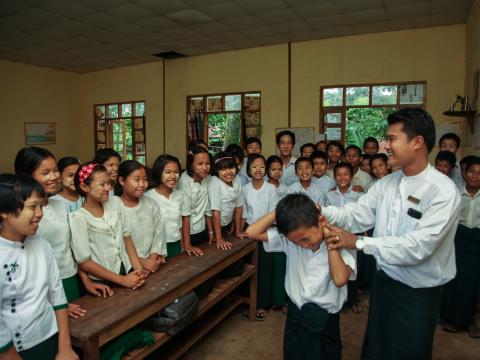DRR Teacher Toolkit Training

With the aim to improve school Disaster Risk Reduction (DRR) awareness of teachers and students, a
‘Training of Trainers' (ToT) programme on school-based DRR was organised by World Vision. Teachers gained awareness and understanding on disaster preparedness along with awareness on disaster risk reduction and building resilience. 29 teachers, from 30 schools located in Hlegu and Hmaw Bi, attended the training.
Teachers, during the school assembly time, replicated the training and empowered their peers and students on school based DRR so that they could be prepared during all stages of a disaster (before, during and after). Children bestowed with the power to bring about change in their communities, further shared their knowledge with family, friends and community members. Some DRR activities were incorporated with ASEAN safe school initiative activities in Hmaw Bi schools.
The teachers, along with the students, also applied the Hazard, Vulnerability and Capacity Assessment (HVCA) tools to develop evacuation plan, giving students a platform to voice their opinions and discuss the risk, vulnerabilities and the prevalent capacity. During discussions, children suggested the possible safe places for evacuation if a disaster would strike during school time.
“Before getting the DRR training, we didn’t have an in-depth understanding about disasters and what to do when our schools experience a hazard. We did not have any emergency exits or fire extinguisher in the school premises. Only after finishing this DRR training, we have learned the steps we need to follow when a disaster strikes to reach safety. We have also learnt how to use the fire extinguisher correctly,” says U Htein Lin Aung, a primary school teacher from Helgu, Yangon.
A total of around 870 children received the DRR awareness from their teachers. A school, in Helgu Yangon, has done Hazard Vulnerability and Capacity Assessment (HVCA) mapping and evacuation plan, and other schools, as part of preparedness, have conducted drill exercises.
“The children will now go back to their family and tell them how to react and follow the procedures during a disaster. Parents will have more aware about DRR and that awareness would spread among the community then to the whole township. They will all be ready when an actual disaster strikes,” says U Htein Lin Aung.
Following the training, child friendly IEC materials are distributed to the school so that children can access and learn from it. The teaching methodologies using the toolkit manual and IEC materials helps the students get the familiarised with the safety and self-protection skills in an emergency.
Quotes from children:
"When a fire breaks out, we must stay calm and as close to one another as possible. We must cover our nose with a wet cloth and run to a place where there is no smoke. If a fire breaks out accidently, at the school, we have to use the fire extinguisher in school to put out the fire and we have to use the emergency exit,” says 12-year-old Pan Nu.
“When there is an earthquake, we have to take cover under the table. When doing so, we have to put our one hand on the neck and another one on the back of the head. The reason to cover our neck and back of the head is because they are the most important vital parts of our body," says 12-year-old Nandar.



